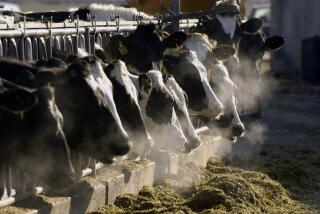Cattle mutilations baffle Colorado ranchers
Reporting from Denver — Manuel A. Sanchez has ruled out every logical explanation for the fate that has befallen the calves on his ranch in southern Colorado.
Over the past month, he’s found four calves dead in a way that he cannot reconcile with anything in his 50 years of raising cattle: eyes and ears missing, tongues and genitals excised in what appeared to be a series of fine cuts.
Mountain lions, bears or coyotes would leave messier marks, he said. And Sanchez found no tire tracks or footprints that would suggest a human invader -- nor even bloodstains he’d expect to find around the carcasses if someone had butchered them.
“There’s nothing to go by,” said Sanchez, who estimated his financial loss at $10,000. “I can’t figure it out.”
Costilla County Sheriff’s Sgt. James Chavez agreed: “There’s nothing to follow up on.”
Besides Sanchez’s calves in San Luis, several cases have been reported near Trinidad.
It’s not the first time.
In the 1970s, ranchers in eastern and southern Colorado filed more than 200 mutilation reports, according to Colorado Bureau of Investigation reports. The agency investigated, even conducting an undercover operation, but to no avail.
“It was such a bewilderment,” recalled Tillie Bishop, a state senator at the time.
Some people suspected satanic cults. Others grew convinced of an otherworldly explanation -- space aliens.
But rancher Bill Bledsoe of Hugo, in eastern Colorado, said the deaths weren’t suspicious at all.
“People find a dead animal and think it died strange, but usually it turned out something had been eating on it,” he said. “I think they were just jumping to conclusions.”
Some veterinarians also attributed the mutilations to predators.
Northern New Mexico suffered scores of cases too. A 1980 report by a state task force blamed predators. Ranchers widely panned it.
Then the mutilations appeared to stop.
But in the mid-1990s, 27 cattle in northern New Mexico were mutilated in 16 months, the Associated Press reported. Again, ranchers found cattle with genitals removed, tongues cut off at the roots, and eyes and ears missing. The incisions appeared to have been cauterized, they said.
Again, the reports stopped.
This year, reports began trickling in from southern Colorado.
In March, Mike Duran discovered a cow dead on his ranch near Trinidad, the udder and vagina missing. “It was like a laser cut,” not a rip, said Duran. He’d seen such carnage before: In the ‘90s, he found a dead cow missing the same parts.
Sheriff’s investigators were mystified. “I don’t know how to explain it. They’re just missing. There’s no evidence of blood, of anything being cut,” said Las Animas County Undersheriff Derek Navarette.
In northeastern Colorado, some Weld County ranchers joke about “coyotes with scalpels,” the Greeley Tribune reported. Some don’t bother reporting mutilations anymore because of skeptics, the paper said.
The Las Animas County sheriff’s office investigated another case in March in which a cow was missing the udder. There was no sign of human or animal presence. “Unexplainable once again,” Navarette said.
He said his office didn’t order necropsies because of the prohibitive cost.
About 100 miles away, Sanchez found two dead calves in late October. A week later, a third carcass was found, and the fourth in mid-November.
Frustrated by the lack of leads, Sanchez consulted Chuck Zukowski, a Colorado Springs paranormal investigator who runs UFOnut.com.
Zukowski also investigated the cases in Trinidad, taking tissue samples from two of those animals to Colorado State University.
Veterinary experts determined that the cuts were made before death and didn’t involve cauterization.
Zukowski says he’s as baffled as everyone else.
Sanchez said that with the mystery unsolved, he didn’t want to risk losing any of his 32 remaining calves the same way. So he sold them at auction this month.
“I didn’t know when this was going to end,” said Sanchez, who has 40 cows left. “There’s no way to catch these people. I don’t even know if it’s people.”
Correll writes for The Times.
More to Read
Sign up for Essential California
The most important California stories and recommendations in your inbox every morning.
You may occasionally receive promotional content from the Los Angeles Times.









